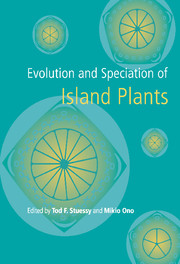Book contents
- Frontmatter
- Contents
- List of contributors
- Preface
- Acknowledgements
- Part one Hawaiian Islands
- Introduction
- 1 Chromosome evolution and speciation in Hawaiian flowering plants
- 2 Evolution in the endemic Hawaiian Compositae
- Part two Juan Fernandez Islands
- Part three Southern and western Pacific Islands
- Part four General evolutionary patterns and processes on oceanic islands
- Author index
- Taxon index
- Subject index
1 - Chromosome evolution and speciation in Hawaiian flowering plants
Published online by Cambridge University Press: 04 May 2010
- Frontmatter
- Contents
- List of contributors
- Preface
- Acknowledgements
- Part one Hawaiian Islands
- Introduction
- 1 Chromosome evolution and speciation in Hawaiian flowering plants
- 2 Evolution in the endemic Hawaiian Compositae
- Part two Juan Fernandez Islands
- Part three Southern and western Pacific Islands
- Part four General evolutionary patterns and processes on oceanic islands
- Author index
- Taxon index
- Subject index
Summary
Abstract
Chromosome numbers available for about 38% of the 956 native species of Hawaiian plants indicate that more than 80% are polyploid. However, support for the occurrence of autochthonous polyploidy is very limited, with fairly clear examples in Peperomia, Portulaca, and Wikstromia; less certain instances in Bobea, Lepidium, Plantago and Psychotria; and dubious examples in Labordia and Polygonum. Likewise, evidence of chromosome evolution in the form of gross structural changes or dysploidy is sparse and clearly demonstrated only in the silversword alliance of Argyroxiphium, Dubautia and Wilkesia. Luzula and Peperomia may provide additional examples of dysploidy. In contrast, a large number of groups, most notably Bidens, Cyrtandra, Hibiscadelphus, Lipochaeta, Pipturus, Scaevola, Tetramolopium, Vaccinium and the lobelioid genera Brighamia, Clermontia, Cyanea, Delissea, Lobelia, Rollandia and Trematolobelia, are seemingly characterized by complete chromosome stasis, at least with respect to gross structural alterations, dysploidy and polyploidy. There appears to be little or no indication that chromosome evolution on the Hawaiian Islands has proceeded in a manner particularly different from continental areas. Rather, the examples of insular chromosome evolution appear to reflect the tendencies inherent in their continental ancestors. In light of the evidence accumulating from molecular studies, it is concluded that the overall patterns of chromosome structural evolution and chromosome stasis observed in plants are most readily explained on the basis of structural variants having different selective values that are determined by the relative positions of critical genes in the genome.
- Type
- Chapter
- Information
- Evolution and Speciation of Island Plants , pp. 5 - 48Publisher: Cambridge University PressPrint publication year: 1998
- 22
- Cited by



